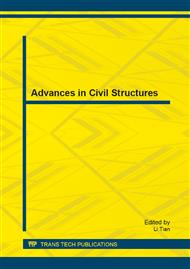p.231
p.237
p.241
p.246
p.250
p.254
p.260
p.264
p.270
The Determination of Friction Coefficient between Parallel Wires in Stay Cables
Abstract:
To measure and determine the friction coefficients of steel wires accurately is one of the prerequisite for analysing the local bending stresses in staycables. Three test schemes to simulate the real working state of the steel wire, the test value and its variation trend shows that the friction coefficient of high-strength steel wires decreases with the pressure increase, and then becomes stable when the positive pressure is too large.
Info:
Periodical:
Pages:
250-253
Citation:
Online since:
August 2013
Authors:
Price:
Сopyright:
© 2013 Trans Tech Publications Ltd. All Rights Reserved
Share:
Citation:


